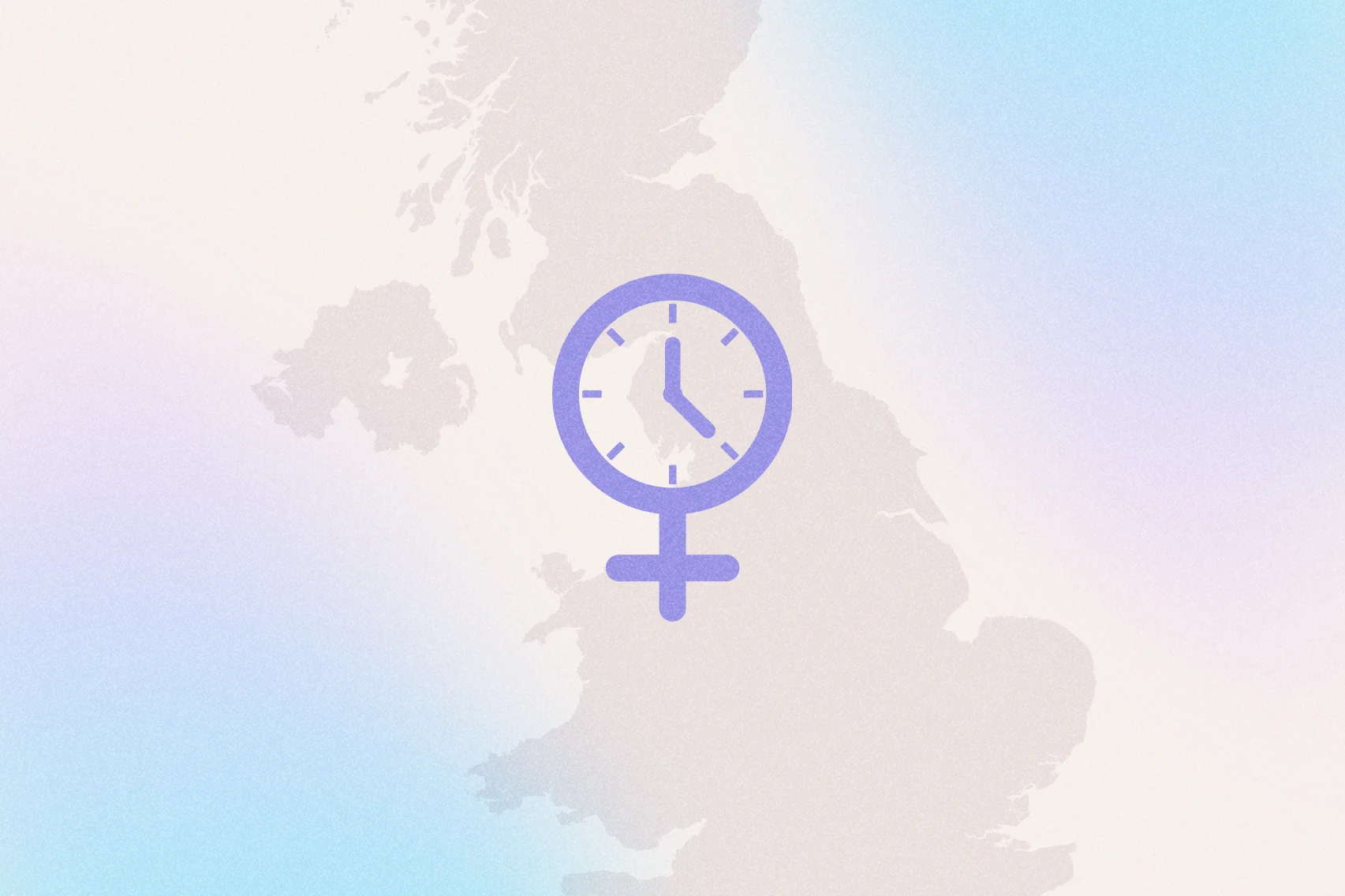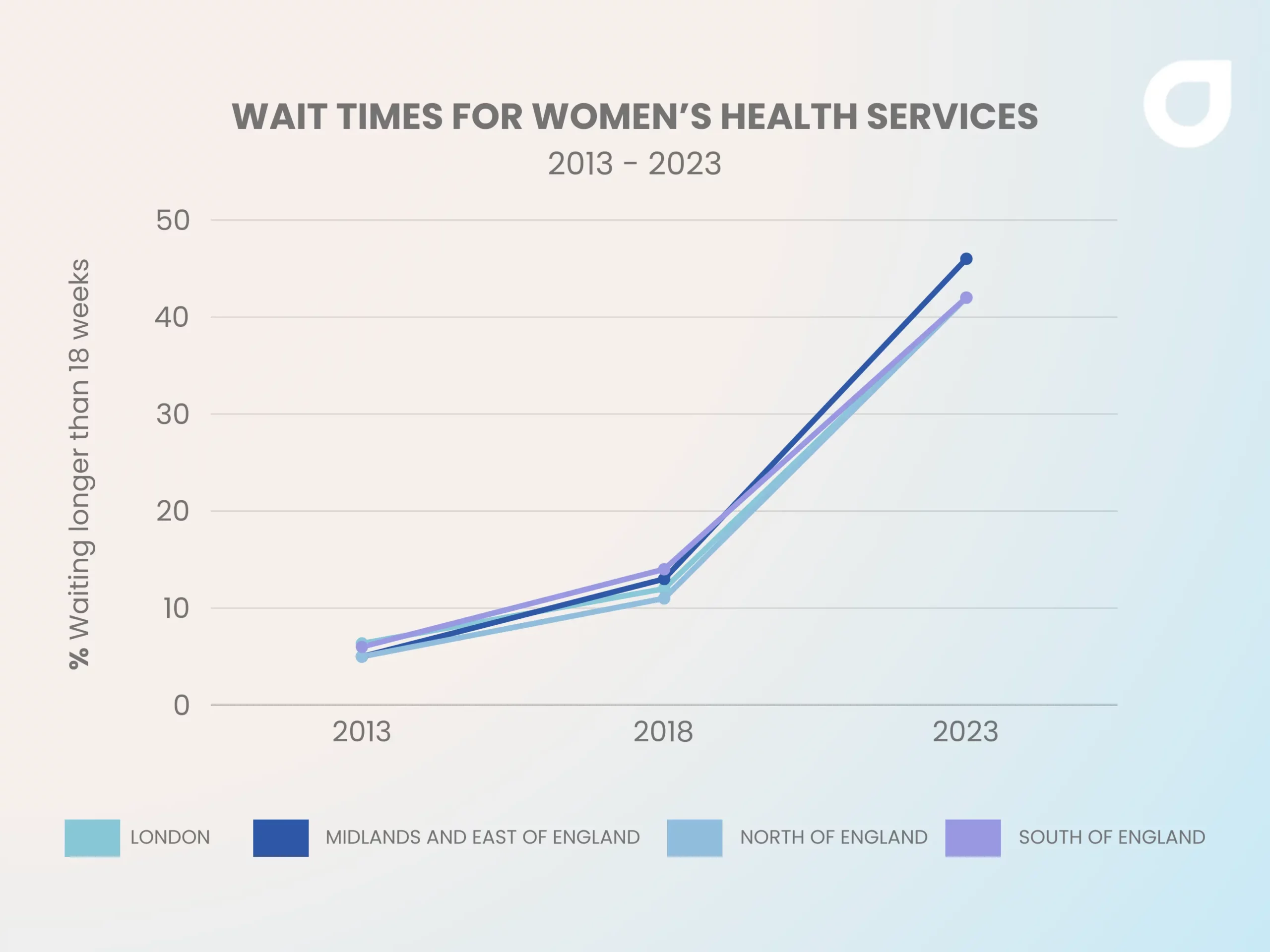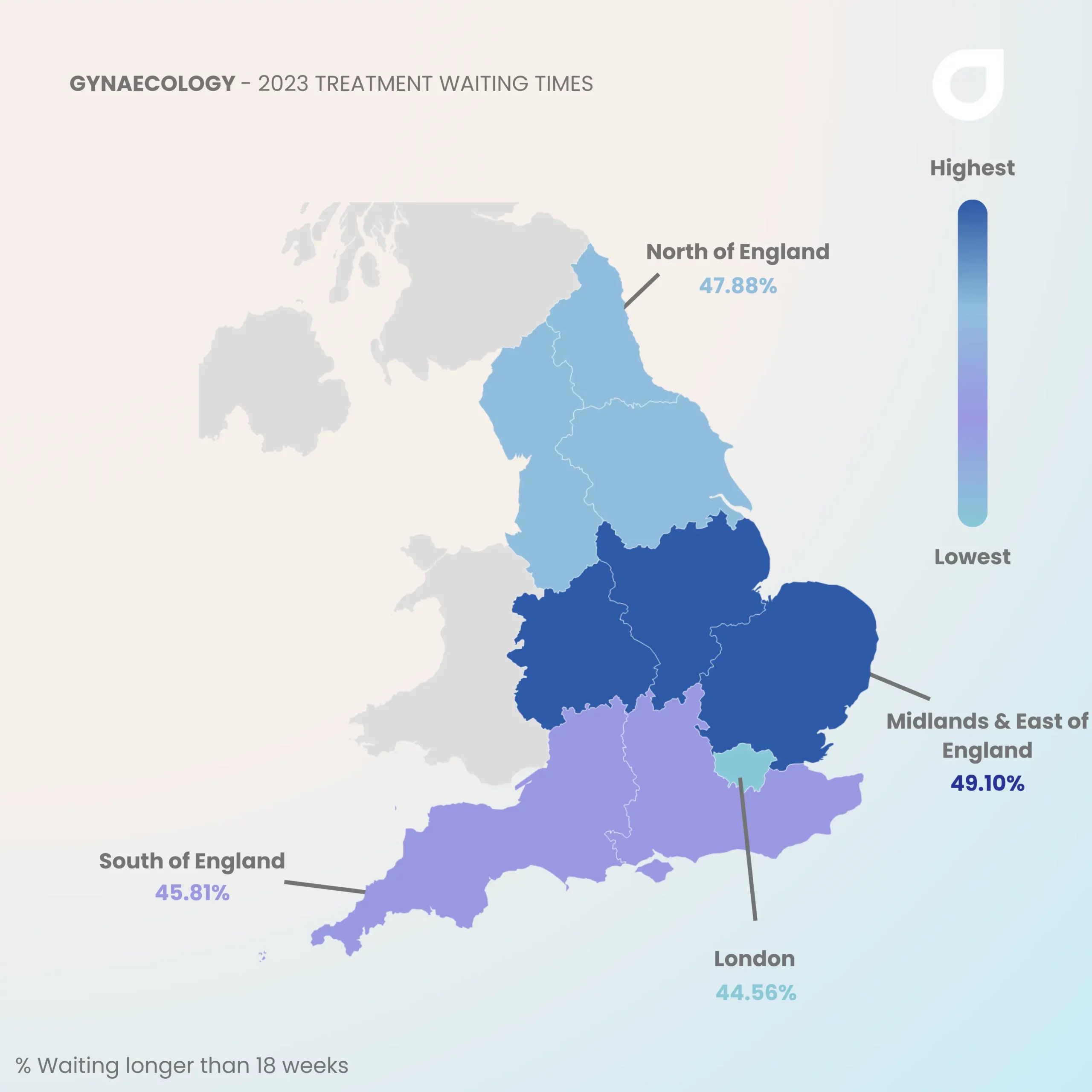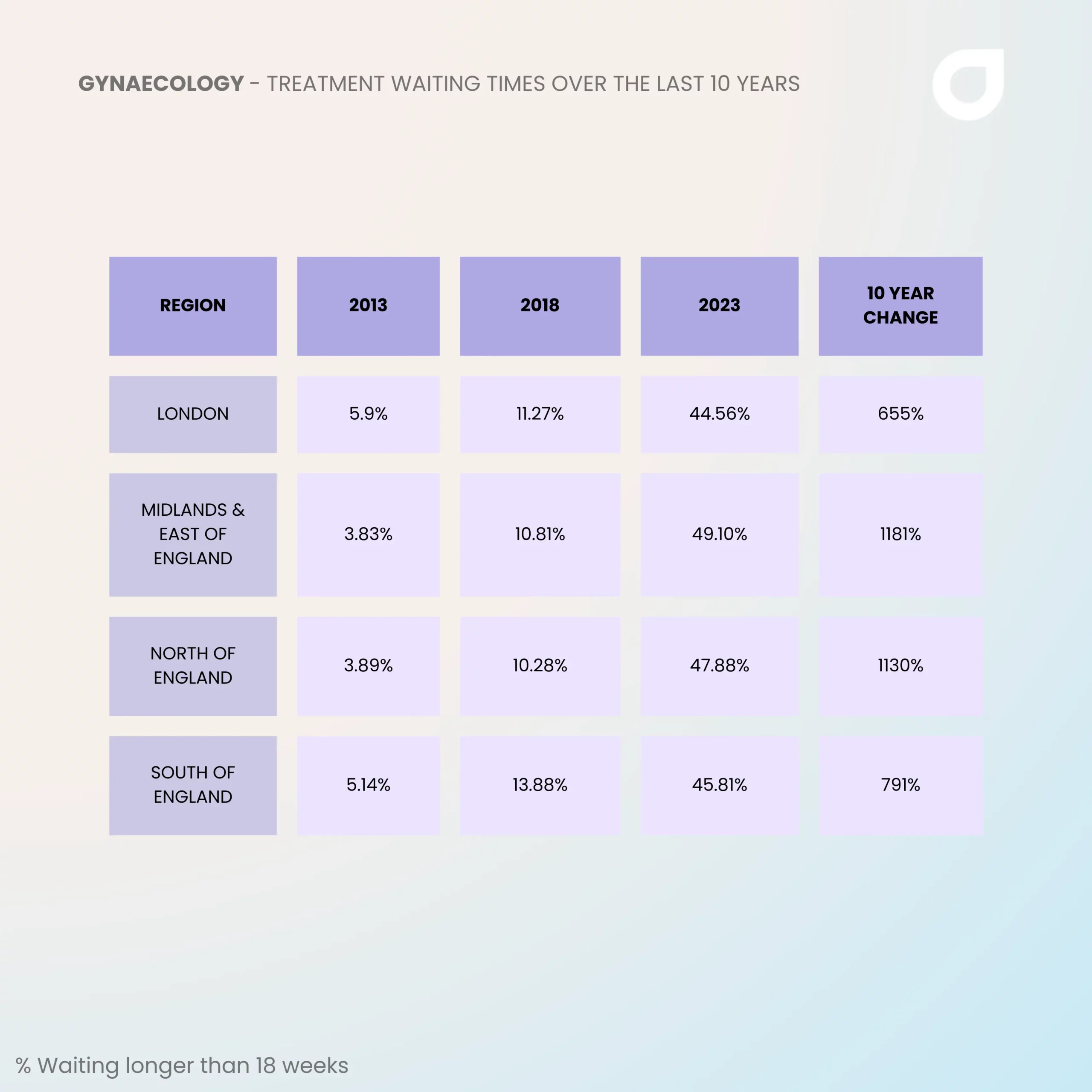Build your own
Build your own test that's specific to your health needs, choosing from our wide range of Biomarkers.
Choose from 30+ markers
5 mins read
Access to women’s healthcare is vital for overall wellbeing; however, thousands of women in England are encountering substantial delays in receiving essential treatments.

Extended wait times are only adding to the inequality women face when it comes to healthcare, exacerbating the gender health gap that already exists in access to timely and adequate medical services.
The National Health Service (NHS) has encountered increasing difficulties in recent years, particularly concerning waiting times for services within women’s health. Recent data indicates a worrying pattern; women are enduring extended delays for necessary treatments and regular check-ups now more than ever.
With this in mind, we at Forth have analysed census data from the Office of National Statistics (ONS) to measure the percentage of women within each area of England, alongside NHS Referral to Treatment (RTT) Waiting Times to gain an understanding of just how much of an impact these prolonged waiting periods are having on women accessing services across the country.
The 18-week target for NHS waiting times, also known as the “Referral to Treatment” (RTT) standard, was announced in 2004 to ensure that patients would need to wait no longer than 18 weeks from their initial referral to begin treatment.
This became a statutory requirement in 2008, as NHS trusts had to guarantee that a minimum of 90% of patients admitted and 95% of non-admitted patients commenced treatment within 18 weeks.
In 2015 Jeremy Hunt, the former Health Secretary, announced that the targets for admitted and non-admitted patients would be eliminated to alleviate the administrative burden on hospitals. But, the overarching goal of treating 92% of patients within 18 weeks remained unchanged.
Despite this, our data reveals that many are facing delays that go far beyond this timeframe, leading to potentially negative consequences for health and overall wellbeing.
Taking a closer look at the data, there are significant differences in waiting times for women’s health treatments across England spanning the past decade.

The Midlands and East of England have witnessed a huge surge in those waiting beyond 18 weeks for treatment throughout the past 10 years. As of 2013, approximately 4.84% of women encountered delays exceeding 18 weeks; fast forward to 2023, this number had skyrocketed to 45.97%.
This represents a huge 850% increase in women waiting for treatment after 18 weeks compared to a decade ago; the largest increase in waiting times of all regions analysed.
The North of England is facing comparable difficulties, with the proportion of women waiting more than 18 weeks rising from 5.25% in 2013 to 41.67% in 2023.
This marks a 694% surge over the last ten years. The region faces significant disparities in access to timely healthcare, highlighting systemic issues that must be urgently addressed to ensure equitable treatment for all women.
The South of England has seen the third-largest increase in women experiencing extended waiting times. The proportion of women waiting for more than 18 weeks for treatment escalated from 5.71% in 2013 to 42.14% in 2023. This indicates an alarming 638% increase compared to ten years ago.
Women in London have seen similar trends in waiting times for procedures, according to our data. In 2013, approximately 6.35% of women were waiting for more than 18 weeks for treatment.
Shockingly, the figure soared to an alarming 41.67% in 2023. This translates to a staggering 556% increase compared to ten years ago.

Breaking the data down even further, our study has revealed startling trends in waiting times for gynaecological treatments.
In London, the proportion of women waiting more than 18 weeks has skyrocketed from 5.90% in 2013 to a worrying 44.56% in 2023. This signifies a notable 655% increase in those waiting for treatment compared to ten years ago.
Similarly, the Midlands and East of England have seen a dramatic rise in waiting times, with the percentage of women waiting over 18 weeks rising from 3.83% in 2013 to 49.10% in 2023. This indicates a 1,181% increase over the past decade.
The North of England and the South of England have also encountered significant rises in waiting times for gynaecological treatments, highlighting systemic challenges in healthcare delivery within this area.

In 2019, promises were made in the Conservative manifesto to boost NHS funding, hire 50,000 more nurses, and construct 40 new hospitals.
Despite the efforts made, the issue of women’s health inequality continues to persist, as women frequently encounter lengthier waiting periods for diagnosis and treatment. Data reveals that conditions, such as endometriosis, typically take an average of eight years to be diagnosed.
In an attempt to tackle these disparities, parliament appointed Dame Lesley Regan as the Women’s Health Ambassador, in a bid to address gender health inequality.
Nevertheless, the actual situation on the ground remains vastly different, as numerous women still endure significant delays and insufficient access to essential healthcare services.
The onset of the pandemic in early 2020 brought unprecedented challenges with resources reallocated resulting in delays for elective procedures.
As a result, meeting the 18-week Referral to Treatment target became increasingly challenging. In response, the Elective Recovery Fund was launched in 2021 to aid NHS trusts in reducing the backlog of elective care by providing additional funding to those meeting waiting time reduction goals.
Despite the injection of funds and implementation of new policies, the backlog for elective treatments continues to persist as a major concern, with critics attributing the issue to long-standing underfunding and mismanagement within the healthcare system.
The significant rise in overall wait times highlights the pressing demand for policy changes and greater funding for women’s healthcare. More than just numbers, these delays result in extended pain and increased health dangers for women throughout the country.
Tackling these obstacles necessitates actions to enhance healthcare accessibility and guarantee prompt care for every woman, no matter where they live or their economic standing.
We analysed ONS (Office of National Statistics) census data, alongside NHS Referral to Treatment (RTT) Waiting Times data to compare the ratio of women in a population to waiting list times listed by the NHS.
In cases where treatment can be assumed to be of even distribution between genders, the appropriate adjustment has been made. In a case such as gynaecology, no adjustment has been made to the figures.
- Health scores calculated
Close